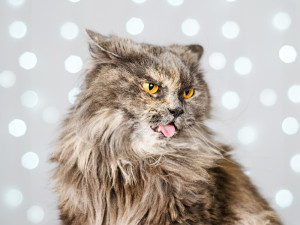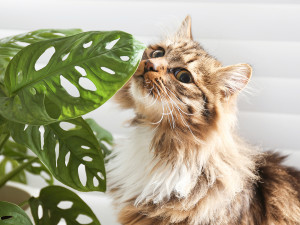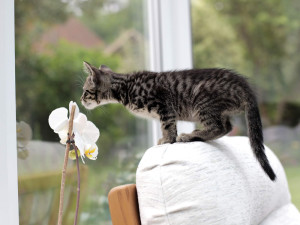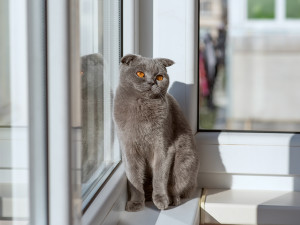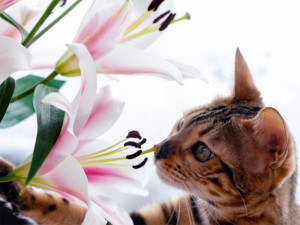Why Is My Cat Vomiting Yellow Liquid? Find Out
Everything you need to know to keep your cat safe and healthy.

Share Article
In This Article:
Why Your Cat Might Be Throwing Up Yellow Liquid When Should You Call Your Vet Treatment For Vomiting in Cats How to Prevent
If you’re a cat parent, you’re likely familiar with hacking, gagging, and retching. They can be sounds that wake you from a dead sleep or send you running through the house at the speed of light trying to get to your cat before they vomit. Yes, cats vomit, and sometimes that vomit consists of yellow liquid. We’ll help you figure out why your cat may be vomiting yellow liquid and what you can do to help.
Why your cat might be throwing up yellow liquid
Vomiting is often the body’s way of getting rid of something that’s irritating the digestive system. When that vomit consists of yellow liquid, it usually means there’s a buildup of bile that’s doing the irritating. With this in mind, here are some reasons a cat might vomit yellow liquid.
Empty stomach
Bile’s main job is to break down fats, and it can be very irritating. Bile is typically released when a cat eats, with the ingested food acting as a buffer so that bile can’t directly irritate the stomach. However, when a cat goes a long time without eating, bile can start irritating the stomach lining, often causing vomiting.

Preparing for surgery, skipping meals, or too much time between meals may all cause your cat to vomit bile. Some cats suffer from bilious vomiting syndromeopens in new tab where they vomit yellow liquid first thing in the morning due to the long period overnight when they aren’t being fed.
Dietary indiscretion
Sometimes vomiting yellow liquid can be as simple as a cat eating something yellow. If your child’s crayon box is missing sunshine yellow, that could be the culprit. Even some commercial cat foods contain yellow pigment that can lead to vomiting yellow, so check your cat food labels.
Eating something they shouldn’t, regardless of the color, can be another cause of vomiting yellow liquid. Things that are indigestible can become lodged in the digestive tract, potentially causing an obstructionopens in new tab, or it can lead to tell-tale irritation, both potentially leading to vomiting bile.
Gastrointestinal issues
Sometimes the cause of vomiting yellow liquid is because the stomach isn’t feeling well. This could mean an infection, inflammation, obstruction, or cancer. This cause includes things affecting the stomach and intestines as well as the liver, gallbladder, and even pancreatitis where the pancreas becomes inflamed and blocks bile flow through the bile duct.
Along with vomiting bile, cats may have a reduced appetite, diarrhea, lethargy, abdominal pain, or yellowing of the skin and eyes.
Hairballs
Cats are persistent groomers; they work their tongues repeatedly through their haircoat in order to remove loose hair and make themselves shine. The tongue takes that loose hair and moves it to the back of the throat where it’s swallowed, packaged with feces, and removed from the body — usually.
Sometimes, a cat can be overcome with so much hair that it doesn’t move itself through. Instead, it can be vomited back up in the form of a hairball. There may be some yellow liquid mixed in with the wet hairball as well.
Food allergies or sensitivities
Food allergie s or sensitivities occur when a cat’s digestive system takes offense to an ingredient in their food. And, as we’ve learned, when the digestive system is offended, it typically responds by vomiting, which can include yellow liquid. Diarrhea and stomach pain may also be seen as well as itchy, rashy skin.
Cats can be allergic to different things, but the most common ingredients are protein sources, such as beef, chicken, or eggs. Sensitivities can be toward dairy, grains, additives, or almost anything else.
Diabetes
When a cat’s body isn’t responding to insulin correctly, it can lead to elevated blood sugar levels which are responsible for all kinds of disruptions. One of those can be vomiting bile, often because a cat isn’t eating.
Kidney disease
The kidneys are in charge of filtering the blood, among many other things. When the blood isn’t filtered properly, toxins can build up and cause nausea and vomiting. If a cat isn’t eating well, their vomit could contain bile. Look for increased water consumption and peeing as well.
When should you call your vet?
Vomiting yellow liquid once or twice usually isn’t a concern, especially if your cat isn’t showing any other signs. However, if they’re vomiting more than twice in 24 hours or it sticks around for the long term, you’ll want to make a vet appointment sooner rather than later.
Seek immediate attention if your cat is showing:
Lethargy
Diarrhea
Stomach pain
Not eating
Yellowing of the skin or eyes
Treatment for vomiting in cats
Your vet is going to start by giving your cat a good look over. They’ll want to know when the vomiting started, other signs you’re seeing, if you’ve tried anything, and if your cat has any other health issues. From there, blood work and imaging may be necessary to check organ function and rule out an obstruction.
Treatment may include supportive care, such as fluids, anti-vomit medications, and anti-inflammatories. Antibiotics may be necessary for infections, a diet change will be in order for food allergies or sensitivities, and supplements for hairballs may be part of treatment as well.
Surgery may be needed to remove foreign objects or tumors if they are causing the problem.
How to prevent vomiting in cats
Your cat is going to vomit from time to time, despite your best efforts, but if you’d like to keep it to a minimum, consider changing the way you feed your cat. This may mean feeding smaller meals more frequently or giving them a snack before bed to tide them over until breakfast. You may also want to change their diet to a limited ingredient or novel protein option if your cat is struggling with food allergies or sensitivities.
You’ll also want to keep your cat from eating things they shouldn’t. Pick up small inedible objects and store them where your cat can’t reach them. Lock up your garbage can and keep food items off your countertops when you’re not around.
Frequent brushing can help as well by removing shed hair before it has a chance to get to your cat’s digestive system.
See your vet regularly to help identify issues when they’re small and to make sure you’re doing all you can to keep your cat healthy and happy.
Bottom line
When a cat vomits yellow liquid, it’s usually bile due to not eating or to a digestive issue that’s causing irritation.
Vomiting bile once may not be a big deal, but if it happens again or is accompanied by other signs, such as lethargy, diarrhea, or stomach pain, contact your veterinarian.
Keep your kitty as healthy and vomit-free as possible by regularly seeing your vet, feeding a good quality diet on a reliable schedule, regular grooming, and keeping them from eating things they shouldn’t.
References
Gibson, Thomas DVM. “Gastrointestinal Obstruction in Small Animals.” Merck Veterinary Manual. Sep 2024. https://www.merckvetmanual.com/digestive-system/diseases-of-the-stomach-and-intestines-in-small-animals/gastrointestinal-obstruction-in-small-animalsopens in new tab.
Johnson, Tony DVM. “Bilious Vomiting Syndrome in Cats and Dogs.” Veterinary Partner.24 Sep 2024. https://veterinarypartner.vin.com/default.aspx?pid=19239&catId=254092&id=12296225opens in new tab.

Dr. Chyrle Bonk, DVM
Dr. Chyrle Bonk has been a mixed-animal veterinarian since 2010, with a special interest in rehabilitation. When she's not practicing or writing about veterinary medicine, you may find her exploring the outdoors with her family or tending to her cows, horses, chickens, or cats and dogs.
Related articles
![cat sniffing a plant]()
Household Plants That Are Toxic to Cats
These plants might be beautiful, but they’re deadly to feline foragers.
Why Does My Cat Eat Grass?
And should they?
Are Carnations Toxic to Cats?
If you receive this flower in a bouquet, keep it away from your cat.
![Half-bengal kitten indoors smelling white orchid flowers in a conservatory.]()
Are Orchids Toxic to Cats?
Find out whether you can get that elaborate flower arrangement—or if you should skip it.
![Uncomfortable looking gray cat sitting on a window sill]()
Should Your Cat Go to the ER?
Here are six good reasons to haul tail to the emergency room.
![Cute Bengal cat sniffs lilly flowers.]()
Are Lilies Toxic to Cats?
This holiday weekend, keep those Easter lilies far away from your kitty.
